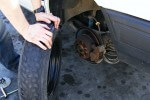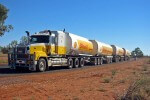Getting to know car jargon is one of the quickest ways to understand your car’s systems and functionality. You would be able to discuss your car or automobiles in general from a knowledge standpoint. You will no longer confuse terms or be confused whenever experts use car related terminologies. Understanding these terms gives you an upper hand or puts you in the same level with other professionals in the automobile industry whenever discussing cars. Here is the glossary of vehicle terminologies for you.

This is an electronic odometer, common with many modern autos
Image source: http://en.wikipedia.org/wiki/Odometer
Cruise control
Sometimes, you need to maintain car speed at a certain level more especially when driving on highways. In that case, you need to employ cruise control. 0-60km/h is one such example. Whenever you read road signs of such nature, you will know their meaning because they are passing a message or reinforcing a rule in that part or section of the road.
Torque
Whenever you want to know the flexibility and strength of a car engine, you will need to check for torque. Torque is the relative force a vehicle engine produces. Understanding torque measurements enable you to make informed decisions when shopping for cars. In other words, torque provides relatively good information you can use in pricing a vehicle under sale.
Chassis
Whenever a person talks about chassis, he/she refers to the metal framework of the vehicle under question. The chassis holds the major parts of a vehicle including suspension system and the car body in general. Besides the strength, a well build chassis defines the shape of the vehicle.
Engine Horse Power
Like torque, horse power is also the measure of engine power. James Watt invented a formula that helped him calculate the power of steam engine. However, this calculation has extended to the automobile industry. Vehicle manufacturers and marketers are using this formula in determining the strength of a vehicle.
Fuel injection systems
Basically, there are two types of fuel injection systems depending on the type of fuel. They include Fuel Stratified Injection, FSI (used with petrol engine) and Turbo Direct Injection, TDI (used with diesel engines). Direct fuel injection system offers better fuel economy while providing the engine relatively more power.
Four Wheel Drive
This is an engine system that has capacity to send power or energy to all four wheels of a conventional vehicle. Such engine systems are superior as they give more power to the vehicle under focus.
RPM
Whenever you have engaged a gear, you can tell how much the engine is working under its current gear by just reading revs per minute, RPM. High revs readings indicate that the engine is laboring hard. Equally, low revs shows that the engine is working normally. Low revs are therefore preferred to high revs. However, lower revs beyond certain levels indicate how lazy and unreliable the engine is working.
Sports Suspension
Manufacturers of cars realized that sports suspensions can reduce the risk of car roll over whenever a driver applies brakes abruptly or when turning corners. Sports suspension therefore, improves your car handling every time you are on the road.
Drive Train
All the systems in a car that provide the car with power consist of drive train. It is also referred to power train. These systems include the wheels, engine and the transmission mechanism.
CO2 Transmission
Whenever the engine undergoes combustion, it produces CO2 otherwise known as exhaust fumes. Understanding the cars CO2 transmission enables you to gauge how environment friendly the car is.






